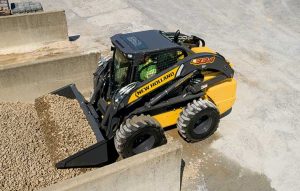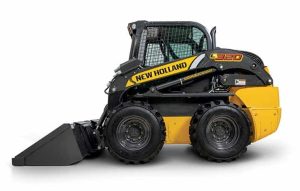Skid Steer Safety – Procedures To Keep You and Your Crew Safe
 are common pieces of equipment found on many job sites. Because of its size, a skid steer can be towed easily behind a pick-up truck and can fit easily in tight spaces, something that most heavy equipment can’t do. The skid steer can accommodate a variety of different tools including utility bucket, hydraulic hammer, broom, tiller, trencher, stump grinder and a list of other attachments. Being able to carry out these tasks, in addition to countless others, make the skid steer loader one of the most popular pieces of equipment on the market. These versatile machines are great for a variety of different jobs, but they are also very dangerous if proper safety procedures are not followed. We will discuss a few important safety procedures that will help keep you and your crew safe.
are common pieces of equipment found on many job sites. Because of its size, a skid steer can be towed easily behind a pick-up truck and can fit easily in tight spaces, something that most heavy equipment can’t do. The skid steer can accommodate a variety of different tools including utility bucket, hydraulic hammer, broom, tiller, trencher, stump grinder and a list of other attachments. Being able to carry out these tasks, in addition to countless others, make the skid steer loader one of the most popular pieces of equipment on the market. These versatile machines are great for a variety of different jobs, but they are also very dangerous if proper safety procedures are not followed. We will discuss a few important safety procedures that will help keep you and your crew safe.
General Safety:
- Inspect jobsite for any obstacles prior to operation. (drop-offs, loose soil, standing water, deep mud).
- Keep your body inside the cab at all times when operating the machine. Never extend your arms, legs or feet beyond the operator’s compartment.
- Always carry loads as low as possible for maximum stability and visibility.
Know Your Surroundings
 Operators: Being aware of your surroundings is one of the most common mistakes that skid steer operators make. A skid steer offers some restrictions when it comes to visibility. From the operator seat, views to the left, right and rear of the machine are very restricted. The loader arms on a skid steer can sometimes block visibility when the machine is carrying a load and caution must be used. Always look in the direction of travel and drive forward whenever possible. Never become so comfortable with your environment that you forget to be on constant lookout for people and obstacles in your path.
Operators: Being aware of your surroundings is one of the most common mistakes that skid steer operators make. A skid steer offers some restrictions when it comes to visibility. From the operator seat, views to the left, right and rear of the machine are very restricted. The loader arms on a skid steer can sometimes block visibility when the machine is carrying a load and caution must be used. Always look in the direction of travel and drive forward whenever possible. Never become so comfortable with your environment that you forget to be on constant lookout for people and obstacles in your path.
Ground Crew: As explained above, skid steer operators have a limited view of their surrounding when in the operator’s seat. When you are working around equipment that is in motion, always remain alert. Jobsite’s are constantly changing. Always know what is in front of you, beside you and above you. ALL construction equipment should also be equipped with backup alarm systems. If you are on foot, keep your ears open.
High-visibility clothing is another way to increase the chances of an operator spotting you. Many companies even supply their employees with highly visible clothing such as vests, hart hats and shirts. This is a simple way to make sure you are safe on the jobsite and it gives operators a better chance of spotting you.
Never Bypass Safety Features
Respect your machine’s safety features. During your daily inspection, ensure safety features are operational and comply with all warning labels. NEVER bypass equipment safety features to start or run a machine and always know ahead of time what safety procedures are in place in the event of equipment malfunction.
Check and use all available protective and safety devices such as roll-over protective structure (ROPS), seat belt, falling-object protective structure (FOPS), safety signs, lift-arm support devices, back-up alarms, guards, etc. Never operate a skid-steer loader that has been damaged or modified.
Bypassing safety features also is a common contributor to skid-steer-related accidents. Of 100 accidents federal OSHA recorded in its Integrated Management Information System from 1997 to 2007, deliberately bypassing safety features was the direct cause of 20 percent. All but one of these accidents was fatal.
Be sure to visit Tracey Road Equipment for any additional information. Our team is available to answer any questions you may have about skid steers or any of the other great products we carry.
